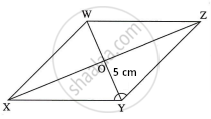Advertisements
Advertisements
प्रश्न
Diagonals of a parallelogram `square`WXYZ intersect each other at point O. If ∠XYZ = 135° then what is the measure of ∠XWZ and ∠YZW?
If l(OY)= 5 cm then l(WY)= ?
उत्तर
Figure:

i. ∠XYZ = 135°
`square`WXYZ is a parallelogram.
∠XWZ = ∠XYZ
∴ ∠XWZ = 135° ...(i)
ii. ∠YZW + ∠XYZ = 180° ...[Adjacent angles of a parallelogram are supplementary]
∴ ∠YZW + 135° = 180° ...[From (i)]
∴ ∠YZW = 180° - 135°
∴ ∠YZW = 45°
iii. l(OY) = 5 cm ...[Given]
I(OY) = `1/2` I(WY) ...[Diagonals of a parallelogram bisect each other]
∴ I(WY) = 2 × l(OY)
∴ I(WY) = 2 × 5
∴ I(WY) = 10 cm
APPEARS IN
संबंधित प्रश्न

Diagonals of a quadrilateral ABCD bisect each other. If ∠A = 35º, determine ∠B.
Points P and Q have been taken on opposite sides AB and CD, respectively of a parallelogram ABCD such that AP = CQ (Figure). Show that AC and PQ bisect each other.

In a parallelogram ABCD, AB = 10 cm and AD = 6 cm. The bisector of ∠A meets DC in E. AE and BC produced meet at F. Find the length of CF.
A diagonal of a parallelogram bisects one of its angles. Show that it is a rhombus.
P and Q are points on opposite sides AD and BC of a parallelogram ABCD such that PQ passes through the point of intersection O of its diagonals AC and BD. Show that PQ is bisected at O.
P is the mid-point of the side CD of a parallelogram ABCD. A line through C parallel to PA intersects AB at Q and DA produced at R. Prove that DA = AR and CQ = QR.
If diagonals of a quadrilateral bisect each other, it must be a parallelogram.
The point of intersection of diagonals of a quadrilateral divides one diagonal in the ratio 1:2. Can it be a parallelogram? Why or why not?
Two sticks each of length 7 cm are crossing each other such that they bisect each other at right angles. What shape is formed by joining their end points? Give reason.
